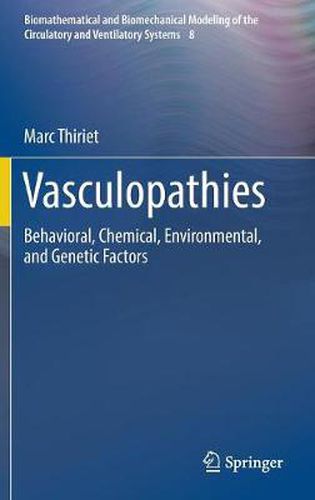Readings Newsletter
Become a Readings Member to make your shopping experience even easier.
Sign in or sign up for free!
You’re not far away from qualifying for FREE standard shipping within Australia
You’ve qualified for FREE standard shipping within Australia
The cart is loading…






This title is printed to order. This book may have been self-published. If so, we cannot guarantee the quality of the content. In the main most books will have gone through the editing process however some may not. We therefore suggest that you be aware of this before ordering this book. If in doubt check either the author or publisher’s details as we are unable to accept any returns unless they are faulty. Please contact us if you have any questions.
This volume presents one of the clinical foundations of vasculopathies: the biological markers and risk factors associated with cardiovascular disease. A detailed biological and clinical framework is provided as a prerequisite for adequate modeling. Chapter 1 presents cardiovascular risk factors and markers, where the search for new criteria is aimed at improving early detection of chronic diseases. The subsequent chapters focus on hypertension, which involves the kidney among other organs as well as many agents, hyperglycemia and diabetes, hyperlipidemias and obesity, and behavior. The last of these risk factors includes altered circadian rhythm, tobacco and alcohol consumption, physical inactivity, and diet.
The volumes in this series present all of the data needed at various length scales for a multidisciplinary approach to modeling and simulation of flows in the cardiovascular and ventilatory systems, especially multiscale modeling and coupled simulations. The cardiovascular and respiratory systems are tightly coupled, as their primary function is to supply oxygen to and remove carbon dioxide from the body’s cells. Because physiological conduits have deformable and reactive walls, macroscopic flow behavior and prediction must be coupled to nano- and microscopic events in a corrector scheme of regulated mechanisms. Therefore, investigation of flows of blood and air in anatomical conduits requires an understanding of the biology, chemistry, and physics of these systems together with the mathematical tools to describe their functioning in quantitative terms.
$9.00 standard shipping within Australia
FREE standard shipping within Australia for orders over $100.00
Express & International shipping calculated at checkout
This title is printed to order. This book may have been self-published. If so, we cannot guarantee the quality of the content. In the main most books will have gone through the editing process however some may not. We therefore suggest that you be aware of this before ordering this book. If in doubt check either the author or publisher’s details as we are unable to accept any returns unless they are faulty. Please contact us if you have any questions.
This volume presents one of the clinical foundations of vasculopathies: the biological markers and risk factors associated with cardiovascular disease. A detailed biological and clinical framework is provided as a prerequisite for adequate modeling. Chapter 1 presents cardiovascular risk factors and markers, where the search for new criteria is aimed at improving early detection of chronic diseases. The subsequent chapters focus on hypertension, which involves the kidney among other organs as well as many agents, hyperglycemia and diabetes, hyperlipidemias and obesity, and behavior. The last of these risk factors includes altered circadian rhythm, tobacco and alcohol consumption, physical inactivity, and diet.
The volumes in this series present all of the data needed at various length scales for a multidisciplinary approach to modeling and simulation of flows in the cardiovascular and ventilatory systems, especially multiscale modeling and coupled simulations. The cardiovascular and respiratory systems are tightly coupled, as their primary function is to supply oxygen to and remove carbon dioxide from the body’s cells. Because physiological conduits have deformable and reactive walls, macroscopic flow behavior and prediction must be coupled to nano- and microscopic events in a corrector scheme of regulated mechanisms. Therefore, investigation of flows of blood and air in anatomical conduits requires an understanding of the biology, chemistry, and physics of these systems together with the mathematical tools to describe their functioning in quantitative terms.